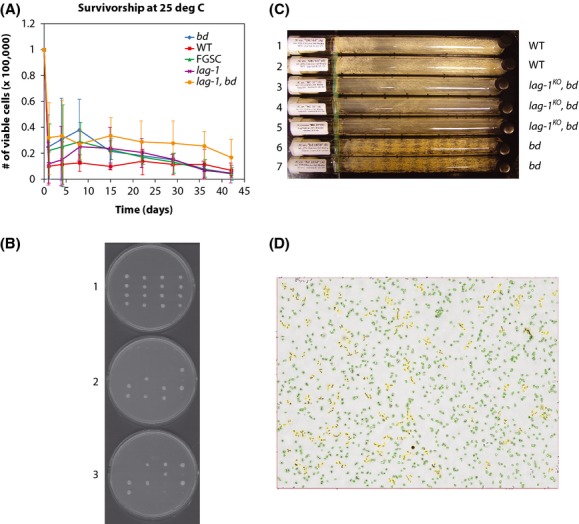Figure 3.

(A) The bd and lag-1 mutations promote chronological life span in N. crassa in three replicate experiments. Two different strains of bd were assayed for chronological life span. Our bd strain is from the FGSC at an earlier date than the later strain labeled FGSC. These curves represent the averages over three independent replicates of the plating experiment. The error bars were computed from 95% confidence bands under a normal approximation (Draper and Smith 1981) (B) Tetrad dissection of N. crassa lag-1 transformants in S. cerevisiae. Tetrads are arranged vertically (1–4 from left to right). (1) Dissected spores from tetrads grown on a −ura plate. (2) Colonies replicated from A grown on a −ura and −leu plate. (3) Colonies replicated from A grown on a −ura and −trp plate. Carbon sources for media are 2% galactose and 2% raffinose. (C) The lag-1KO, bd -31 double mutant can stop the biological clock output as displayed in the asexual reproduction of spores along race tubes (3–5) during 7 days of growth from one end to the other end of the race tubes. As a control, a bd mutant (FGSC 1858) is shown banding (tubes 6–7), that is, reproducing on a 22-h cycle, while WT (OR74A) is shown not banding (tubes 1–2) under these growth conditions. All tubes were maintained in the dark at 25°C. All strains were grown on glucose (0.15%) as described in the methods. Average growth rates of bd, lag-1KO, bd -31, and WT were 0.86, 0.99, and 2.20 mm/h on glucose (0.15%). (D) The bd, lag-1 (−31) double mutant has a chain phenotype with 100× objective. Many of the chains of conidia are colored yellow. Apparently some of the conidia fail to divide successfully.
